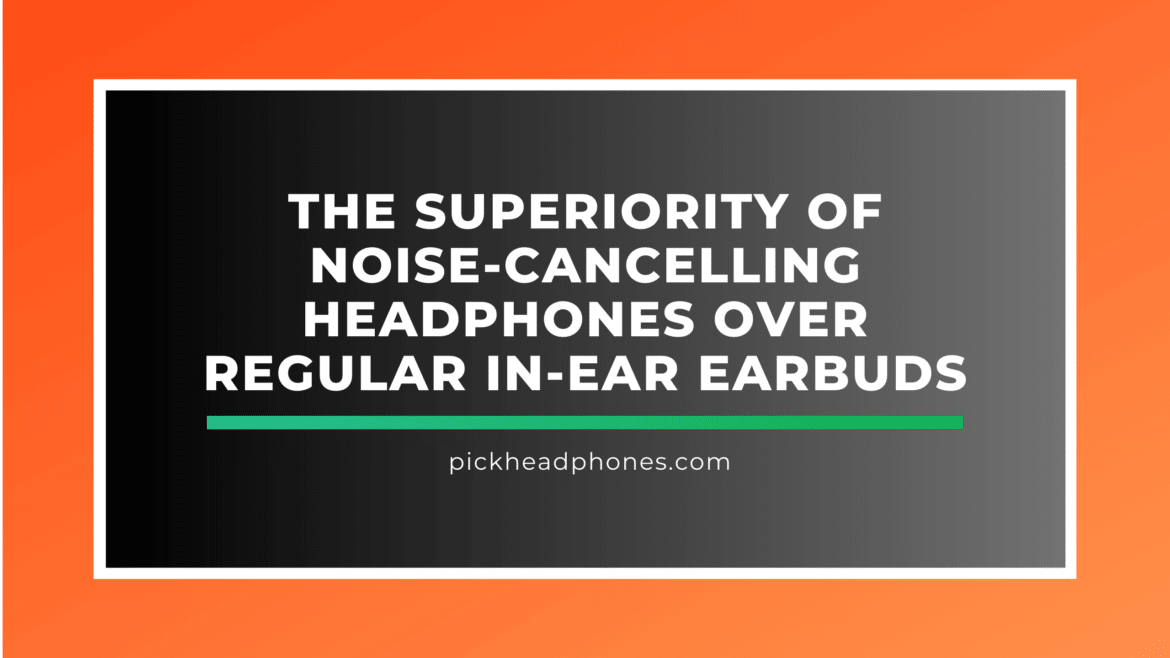- In what environments are noise-cancelling headphones particularly effective?
- How do noise-cancelling headphones compare to in-ear earbuds in terms of sound quality?
- What are the comfort benefits of using noise-cancelling headphones for prolonged periods?
- How do noise-cancelling headphones contribute to protecting your hearing?
- Why are noise-cancelling headphones superior for enhancing focus and concentration in noisy environments?
In the world of personal audio, the choice between noise-cancelling headphones and regular in-ear earbuds is pivotal. Understanding the technology behind noise-cancelling headphones and the design of in-ear earbuds is key. Noise-cancelling headphones use active noise control to counteract ambient sound, whereas in-ear earbuds rely on passive noise isolation, which blocks some sounds through their physical design.

Situations Where Noise-Cancelling Headphones Excel
1. Environments with Consistent Noise
How Noise-Cancellation Works in Noisy Settings
In environments with consistent, low-frequency noise, such as airplanes or trains, noise-cancelling headphones are significantly more effective. These headphones use microphones to pick up external sounds and generate sound waves that are precisely the opposite (anti-phase) to cancel out ambient noise.
Embedded Table: Noise Reduction Comparison
| Environment | Noise-Cancelling Headphones Reduction | In-Ear Earbuds Reduction |
|---|---|---|
| Airplane | Up to 20-30 dB | 10-15 dB |
| Train | Up to 25 dB | 10-12 dB |
| Office | Up to 15-20 dB | 5-10 dB |
2. Sound Quality: A Key Factor
The Superiority in Sound
Noise-cancelling headphones often provide a richer sound quality compared to regular earbuds. The larger drivers in these headphones offer a wider range of frequencies and better bass response.
Embedded Table: Sound Quality Comparison
| Feature | Noise-Cancelling Headphones | In-Ear Earbuds |
|---|---|---|
| Driver Size | Larger (typically 40mm+) | Smaller |
| Frequency Response | Broader | More limited |
| Bass Response | Superior | Moderate |

3. Comfort for Prolonged Use
Ergonomic Design Benefits
For extended listening sessions, the over-ear design of noise-cancelling headphones can be more comfortable, distributing pressure around the ears rather than inside the ear canal.
Embedded Table: Comfort Comparison
| Duration | Noise-Cancelling Headphones Comfort | In-Ear Earbuds Comfort |
|---|---|---|
| 0-2 hours | High | Very High |
| 2-4 hours | High | Moderate |
| 4+ hours | Very High | Low |
4. Protecting Your Hearing
Safe Listening Levels
Noise-cancelling headphones can help maintain lower volume levels, protecting your hearing. By reducing background noise, users don’t need to increase the volume excessively to overcome ambient sounds.
5. Enhancing Focus and Concentration
Creating a Controlled Listening Environment
In situations requiring high concentration, like studying or working in a library, noise-cancelling headphones can help by blocking distracting noises, allowing for a more focused and productive environment.
6. Ideal for Certain Physical Activities

Noise-Cancellation in Active Settings
While in-ear buds are often chosen for sports, noise-cancelling headphones are better for activities in noisy areas, providing a more immersive experience without external distractions.
Conclusion: Making the Right Choice
While noise-cancelling headphones offer several advantages over regular in-ear earbuds, including better noise reduction, sound quality, and comfort for prolonged use, they are also bulkier and generally more expensive. The choice ultimately depends on your specific needs, preferences, and the environments in which you’ll use them. Whether you prioritize immersion in your audio experience or need something compact and lightweight for active use, understanding these key differences will guide you in making the best choice for your personal audio needs.
Last Updated on January 14, 2024
